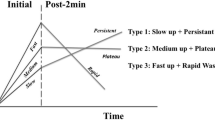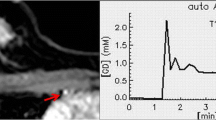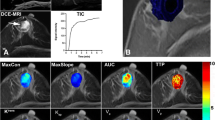Abstract
Objective
To find out any correlation between dynamic contrast-enhanced (DCE) model-based parameters and model-free parameters, and evaluate correlations between perfusion parameters with histologic prognostic factors.
Methods
Model-based parameters (Ktrans, Kep and Ve) of 102 invasive ductal carcinomas were obtained using DCE-MRI and post-processing software. Correlations between model-based and model-free parameters and between perfusion parameters and histologic prognostic factors were analysed.
Results
Mean Kep was significantly higher in cancers showing initial rapid enhancement (P = 0.002) and a delayed washout pattern (P = 0.001). Ve was significantly lower in cancers showing a delayed washout pattern (P = 0.015). Kep significantly correlated with time to peak enhancement (TTP) (ρ = −0.33, P < 0.001) and washout slope (ρ = 0.39, P = 0.002). Ve was significantly correlated with TTP (ρ = 0.33, P = 0.002). Mean Kep was higher in tumours with high nuclear grade (P = 0.017). Mean Ve was lower in tumours with high histologic grade (P = 0.005) and in tumours with negative oestrogen receptor status (P = 0.047). TTP was shorter in tumours with negative oestrogen receptor status (P = 0.037).
Conclusions
We could acquire general information about the tumour vascular physiology, interstitial space volume and pathologic prognostic factors by analyzing time-signal intensity curve without a complicated acquisition process for the model-based parameters.
Key points
• Kep mainly affected the initial and delayed curve pattern in time–signal intensity curve.
• There is significant correlation between model-based and model-free parameters.
• We acquired information about tumour vascular physiology, interstitial space volume and prognostic factors.



Similar content being viewed by others
References
Peters NH, Borel Rinkes IH, Zuithoff NP, Mali WP, Moons KG, Peeters PH (2008) Meta-analysis of MR imaging in the diagnosis of breast lesions. Radiology 246:116–124
Kuhl CK, Mielcareck P, Klaschik S et al (1999) Dynamic breast MR imaging: are signal intensity time course data useful for differential diagnosis of enhancing lesions? Radiology 211:101–110
Yankeelov TE, Gore JC (2009) Dynamic contrast enhanced magnetic resonance imaging in oncology: theory, data acquisition, analysis, and examples. Curr Med Imaging Rev 3:91–107
Koo HR, Cho N, Song IC et al (2012) Correlation of perfusion parameters on dynamic contrast-enhanced MRI with prognostic factors and subtypes of breast cancers. J Magn Reson Imaging 36:145–151
Li SP, Padhani AR, Taylor NJ et al (2011) Vascular characterisation of triple negative breast carcinomas using dynamic MRI. Eur Radiol 21:1364–1373
El Khouli RH, Macura KJ, Kamel IR, Jacobs MA, Bluemke DA (2011) 3-T dynamic contrast-enhanced MRI of the breast: pharmacokinetic parameters versus conventional kinetic curve analysis. AJR Am J Roentgenol 197:1498–1505
Tofts PS (1997) Modeling tracer kinetics in dynamic Gd-DTPA MR imaging. J Magn Reson Imaging 7:91–101
Tofts PS, Brix G, Buckley DL et al (1999) Estimating kinetic parameters from dynamic contrast-enhanced T(1)-weighted MRI of a diffusable tracer: standardized quantities and symbols. J Magn Reson Imaging 10:223–232
Benndorf M, Baltzer PA, Kaiser WA (2011) Assessing the degree of collinearity among the lesion features of the MRI BI-RADS lexicon. Eur J Radiol 80:e322–e324
Veltman J, Stoutjesdijk M, Mann R et al (2008) Contrast-enhanced magnetic resonance imaging of the breast: the value of pharmacokinetic parameters derived from fast dynamic imaging during initial enhancement in classifying lesions. Eur Radiol 18:1123–1133
Furman-Haran E, Schechtman E, Kelcz F, Kirshenbaum K, Degani H (2005) Magnetic resonance imaging reveals functional diversity of the vasculature in benign and malignant breast lesions. Cancer 104:708–718
Yu Y, Jiang Q, Miao Y et al (2010) Quantitative analysis of clinical dynamic contrast-enhanced MR imaging for evaluating treatment response in human breast cancer. Radiology 257:47–55
Li X, Arlinghaus LR, Ayers GD et al (2013) DCE-MRI analysis methods for predicting the response of breast cancer to neoadjuvant chemotherapy: pilot study findings. Magn Reson Med. doi:10.1002/mrm.24782
Yu HJ, Chen JH, Mehta RS, Nalcioglu O, Su MY (2007) MRI measurements of tumor size and pharmacokinetic parameters as early predictors of response in breast cancer patients undergoing neoadjuvant anthracycline chemotherapy. J Magn Reson Imaging 26:615–623
Li SP, Taylor NJ, Makris A et al (2010) Primary human breast adenocarcinoma: imaging and histologic correlates of intrinsic susceptibility-weighted MR imaging before and during chemotherapy. Radiology 257:643–652
Miller JC, Pien HH, Sahani D, Sorensen AG, Thrall JH (2005) Imaging angiogenesis: applications and potential for drug development. J Natl Cancer Inst 97:172–187
Radjenovic A, Dall BJ, Ridgway JP, Smith MA (2008) Measurement of pharmacokinetic parameters in histologically graded invasive breast tumours using dynamic contrast-enhanced MRI. Br J Radiol 81:120–128
Fluckiger JU, Schabel MC, Dibella EV (2012) The effect of temporal sampling on quantitative pharmacokinetic and three-time-point analysis of breast DCE-MRI. Magn Reson Imaging 30:934–943
Knopp MV, von Tengg-Kobligk H, Choyke PL (2003) Functional magnetic resonance imaging in oncology for diagnosis and therapy monitoring. Mol Cancer Ther 2:419–426
Craciunescu OI, Blackwell KL, Jones EL et al (2009) DCE-MRI parameters have potential to predict response of locally advanced breast cancer patients to neoadjuvant chemotherapy and hyperthermia: a pilot study. Int J Hyperthermia 25:405–415
Baltzer PA, Vag T, Dietzel M et al (2010) Computer-aided interpretation of dynamic magnetic resonance imaging reflects histopathology of invasive breast cancer. Eur Radiol 20:1563–1571
Roberts C, Issa B, Stone A, Jackson A, Waterton JC, Parker GJ (2006) Comparative study into the robustness of compartmental modeling and model-free analysis in DCE-MRI studies. J Magn Reson Imaging 23:554–563
Thukral A, Thomasson DM, Chow CK et al (2007) Inflammatory breast cancer: dynamic contrast-enhanced MR in patients receiving bevacizumab–initial experience. Radiology 244:727–735
Yi A, Cho N, Im SA et al (2013) Survival outcomes of breast cancer patients who receive neoadjuvant chemotherapy: association with dynamic contrast-enhanced MR imaging with computer-aided evaluation. Radiology 268:662–672
Acknowledgement
The scientific guarantor of this publication is Dr. Tae Hee Kim. The authors of this manuscript declare no relationships with any companies, whose products or services may be related to the subject matter of the article. This study has received funding by a faculty research grant of Ajou University School of Medicine for 2011. No complex statistical methods were necessary for this paper. Institutional review board approval was obtained. Written informed consent was obtained from all subjects (patients) in this study. Methodology: prospective, observational, performed at one institution.
Author information
Authors and Affiliations
Corresponding author
Rights and permissions
About this article
Cite this article
Yi, B., Kang, D.K., Yoon, D. et al. Is there any correlation between model-based perfusion parameters and model-free parameters of time-signal intensity curve on dynamic contrast enhanced MRI in breast cancer patients?. Eur Radiol 24, 1089–1096 (2014). https://doi.org/10.1007/s00330-014-3100-6
Received:
Revised:
Accepted:
Published:
Issue Date:
DOI: https://doi.org/10.1007/s00330-014-3100-6




